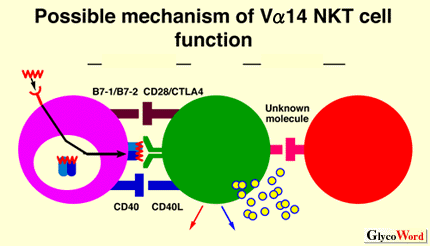|
V alpha 14 NKT Cells - A Novel Lymphocyte Specific for Glycolipid antigens
|
 |
|
 |
V alpha 14 NKT cells are a novel line of lymphocytes characterized by co-expression of an invariant antigen receptor (V alpha 14) and an NK marker, NK1.1. V alpha 14 NKT cells are a major source of interleukin-4 and interferon-gamma in vivo, exert cytotoxicity against tumor cells, and play a role in the onset of autoimmune diseases. V alpha 14 NKT cells recognize a non-classical MHC class I molecule CD1d; and mice deficient for the CD1d have a drastically reduced number of V alpha 14 NKT cells. The ligand for the V alpha 14 antigen receptor, however, remained elusive until recently. In 1997, we identified for the first time one such ligand through experiments using V alpha 14 NKT cell-deficient mice and V alpha 14 NKT mice generated by gene targeting and transgenic technologies (1). The ligand for V alpha 14 receptor turned out to be a glycosphingolipid, alpha-galactosylceramide (alpha-GalCer). The alpha-galactosylceramide activates V alpha 14 NKT cells to be cytotoxic against tumor cells in vitro, and causes experimental metastatic tumor rejection when injected in vivo (2).
Although glycosylceramides are a major component of the mammalian body, only beta-anomers have been known. The alpha-galactosylceramide, therefore, may represent an exogenous antigen. By contrast, glycophosphatidylinositol (GPI) has recently been reported to be a natural ligand for CD1d (3). The immune system can recognize peptide and oligosaccharide antigens via conventional T cells and NK cells, respectively. The current study has shed light to a novel mode of antigen recognition by immune cells, i.e. the recognition of glycolipids by V alpha 14 NKT cells. |
|
|
 |
|
|
Tetsu Kawano and Masaru Taniguchi (Department of Molecular Immunology, Graduate School of Medicine, Chiba University ) |
|
|
|
| References |
(1) |
Kawano, T et al. Science 278, 1626-1629, 1997 |
|
(2) |
Kawano, T et al. Proc. Natl. Acad. Sci. USA, 95, 5690-5693, 1998 |
|
(3) |
Joyce, S et al. Science 279, 1541-1544, 1998 |
|
|
|
|
|
|
| Jun.15, 1998 |
|
|
|
|
|
|
|



